Have you ever found yourself facing a clogged toilet and wondering if drain cleaner could be the solution?
We will explore the different types of drain cleaners available, how they work, and whether they can effectively unclog a toilet.
Additionally, we will discuss the risks associated with using drain cleaner on a toilet and offer some alternative methods for unclogging your toilet.
Stay tuned to find out everything you need to know about using drain cleaner on a toilet.
Take a look: How To Clean Drain In Bathroom Sink
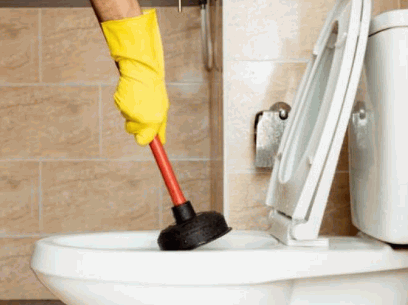
A drain cleaner is a chemical product designed to remove blockages and blockages in drains, particularly in plumbing systems such as toilets. These cleaners are formulated to dissolve or dislodge the substances causing the obstruction, allowing water to flow freely through the drain.
They work by utilising various active ingredients that can break down matter like hair, grease, soap scum, or food particles stuck in the pipes. The two main types of drain cleaners are chemical-based and mechanical drain cleaners. Chemical drain cleaners use strong acids or bases to chemically react with the blockage and dissolve it, while mechanical drain cleaners physically break up the blockage using tools like augers or plumber's snakes.
Each type has its own strengths and is suitable for different kinds of blockages. While chemical cleaners are quick and effective for minor blockages, mechanical cleaners are more suited for stubborn or deep-seated obstructions needing physical intervention.
Drain cleaners work by utilising chemical reactions to break down and dissolve the materials causing blockages in drains, including those in toilets. These chemicals create heat or gas to dislodge blockages and clear the pathway for water to flow smoothly through the drain.
When drain cleaners come into contact with the blockage, they react with the substances causing the blockage. For example, acidic drain cleaners typically contain sulphuric acid or hydrochloric acid that can dissolve organic materials like hair or soap scum. On the other hand, alkaline drain cleaners use ingredients such as sodium hydroxide to saponify fats and oils, turning them into a soap-like substance that can be easily rinsed away. These chemical reactions help break down the blockage into smaller pieces, making it easier to flush down the drain.
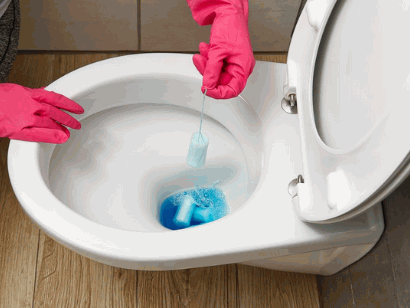
There are several types of drain cleaners available in the market, each with its unique formulation and mechanism of action. The main categories include chemical drain cleaners, enzymatic drain cleaners, and hydro-mechanical drain cleaners, each tailored to address specific types of blockages.
Chemical drain cleaners generally contain strong chemicals like sulphuric acid or sodium hydroxide, which dissolve organic matter and hair blockages effectively. They are quick-acting but can be corrosive and harmful if not used properly. Enzymatic drain cleaners, on the other hand, use natural enzymes to break down and digest organic waste, being safer for pipes and the environment. Hydro-mechanical drain cleaners, such as drain snakes or augers, physically remove blockages by breaking them up or pulling them out.
Drain cleaners can help unblock a toilet in some cases, depending on the nature and severity of the blockage. It is essential to consider various factors before using drain cleaner on a toilet to avoid potential risks or damage to the plumbing system.
When facing a minor blockage caused by organic matter or soap scum, a drain cleaner specifically formulated for toilets can be effective in breaking down the obstruction. These cleaners typically contain chemicals that react with the blockage, dissolving it and allowing water to flow freely again. Yet, it's crucial to note that stubborn blockages, such as those caused by non-organic matter or deep-seated blockages, may not respond well to standard drain cleaners.
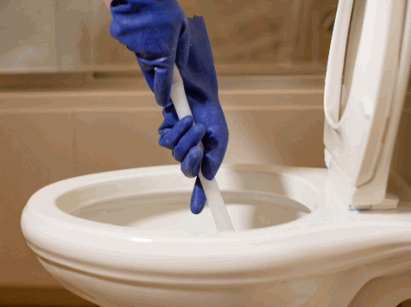
Before using drain cleaner on a toilet, it is crucial to assess the severity of the blockage, the type of cleaner being used, and the potential risks associated with chemical treatments. Consider seeking professional assistance from a plumber for complex or persistent blockages.
When dealing with a blocked toilet, one must always keep in mind the potential hazards that come with using chemical drain cleaners. These substances can be harmful to your health and the environment if not handled properly.
Understanding the type of blockage you are facing is vital in determining the appropriate course of action. Different blockages may require different methods for effective removal.
For example, a plumber can provide expert advice and solutions for more challenging situations, ensuring that the issue is resolved efficiently and effectively.
When using drain cleaner on a toilet, start by following the instructions provided on the cleaner packaging. Typically, pour the recommended amount of the cleaner into the toilet bowl, allow it to work for the specified duration, and then flush the toilet to clear the blockage.
For stubborn blockages that the cleaner alone may not resolve, you can use a plunger or a plumbing snake to dislodge the obstruction. Make sure to wear protective gloves and goggles to avoid direct contact with the cleaner and any splashes that may occur. Safety first is crucial while handling chemical cleaners. Always keep the area well-ventilated to prevent inhaling harmful vapours.
Once you have cleared the blockage, carefully dispose of any remaining cleaner following the manufacturer's instructions or local disposal regulations. Taking these precautions not only ensures the efficacy of the cleaner but also helps prevent incidents and environmental damage.
Using drain cleaner on a toilet carries certain risks, including potential damage to toilet pipes, exposure to harmful chemicals, and the risk of accidental injury during the application or handling of the cleaner.
When drain cleaner comes into contact with the porcelain and rubber components in a toilet, it can lead to corrosion and weakening of the pipes over time, potentially causing leaks and costly repairs. The chemicals in drain cleaners can also release toxic fumes, posing health risks to individuals inhaling them, especially in poorly ventilated areas.
To avoid these dangers, it is advisable to consider alternative methods such as using a toilet plunger or a plumbing snake to clear blockages. These tools are effective in unblocking toilets without the associated risks of chemical exposure or pipe damage.
Always remember to wear protective gear like gloves and goggles when handling cleaning agents to prevent any accidental skin or eye contact. Proper ventilation is also crucial to minimise the inhalation of fumes, ensuring a safer environment for all occupants.
The use of certain drain cleaners in toilets can lead to damage to the toilet pipes, especially in cases of prolonged exposure or incorrect application. Harsh chemicals may corrode or weaken the pipes, exacerbating the existing blockage issues.
Potentially harmful effects may manifest through visible signs such as leaks, foul odours, or slow drainage, indicating underlying pipe damage. It is crucial to promptly address these warning signals to prevent costly repairs or more extensive plumbing problems. To safeguard the longevity of your toilet pipes, opt for gentle, non-corrosive alternatives recommended by professionals. Regular maintenance and occasional inspections can help detect early signs of damage caused by drain cleaners, ensuring the health and functionality of your plumbing system.
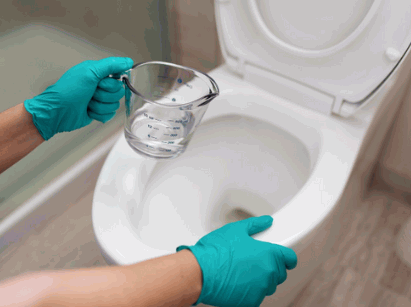
Many drain cleaners contain harsh chemicals that can pose health risks when used in toilets, especially in enclosed spaces. These chemicals may emit fumes or residues that can damage the porcelain surfaces of the toilet and cause environmental contamination.
The acids and caustic substances present in traditional drain cleaners not only harm the toilet materials but can also react with water or other substances, creating potentially toxic byproducts. Inhaling these fumes can irritate the respiratory system and exacerbate existing health conditions. The release of these chemicals into the drainage system can harm aquatic life and contaminate water sources.
To combat these risks, consider using natural or enzyme-based alternatives that are gentler on both your health and the environment. Vinegar, baking soda, or specialised bio-drain cleaners are effective options that do not pose the same level of danger. When handling any type of drain cleaner, always wear protective gear such as gloves and goggles, and follow the manufacturer's instructions for proper use and disposal.
There is a notable risk of injury when using drain cleaner on a toilet, primarily due to accidental spills, splashes, or improper handling of the chemical products. Direct contact with certain drain cleaners can cause skin irritation or more severe injuries.
It is crucial for individuals to take necessary precautions to protect themselves from these potential hazards. Wearing protective gear such as gloves, eye protection, and long-sleeved clothing is essential when handling drain cleaners. Ensuring proper ventilation in the area where the cleaning is taking place can help minimise the risk of inhaling harmful fumes. In case of accidental exposure, it is important to immediately rinse the affected area with water and seek medical attention if symptoms persist or worsen.
In situations where using drain cleaner on a toilet is not advisable, there are alternative methods to unblock the toilet effectively. These include using a plunger, employing a toilet auger or snake, or trying natural remedies such as baking soda and vinegar solutions.
Plungers are a common tool found in many households and are effective in dislodging minor toilet blockages. To use a plunger, ensure a firm seal between the plunger and the toilet drain to create suction. Vigorous plunging motion up and down several times can often break up the blockage and allow water to flow freely.
A toilet auger or snake is a more specialised tool that can tackle tougher blockages. Insert the auger into the toilet drain and rotate the handle to maneuver it through the pipes, breaking up or pulling out the obstruction.
Natural remedies like a mixture of baking soda and vinegar can also help dissolve organic matter causing the blockage. Pour the baking soda into the toilet, followed by vinegar, and let the fizzing action work its way through the blockage before attempting to flush.
A plunger is a simple yet effective tool for unblocking toilets by creating pressure to dislodge blockages in the drain. To use a plunger, place the rubber end over the toilet drain, create a seal, and push and pull the plunger handle to generate suction and force the blockage to clear.
There are various types of plungers available for different purposes. The most common is the cup plunger, which is excellent for toilets because of its shape and flexibility. For sinks and flat drains, a flange plunger with its extended rubber flap is more suitable. Remember to use a plunger with a handle that offers a good grip to prevent slipping during use. Avoid using excessive force as this could harm the pipes, but instead apply constant pressure to dislodge the blockage.
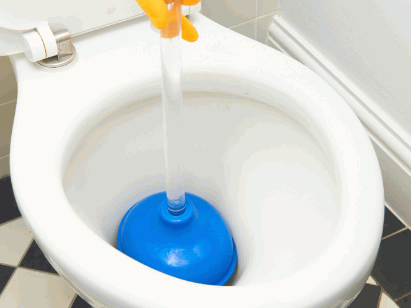
A toilet auger, also known as a toilet snake, is a specialised tool designed to navigate through the toilet drain and dislodge blockages beyond the reach of a plunger. This flexible auger features a coiled wire or cable that can be extended into the drain to break apart blockages.
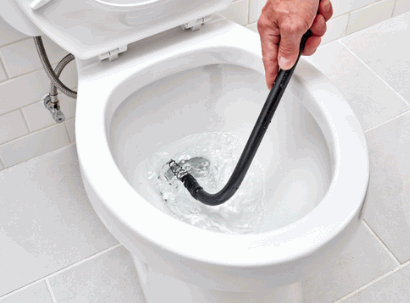
Natural remedies such as a mixture of bicarbonate of soda, vinegar, and hot water can serve as an eco-friendly and safe alternative to chemical drain cleaners for toilets. This combination creates a foaming reaction that can help break down organic clogs without damaging the plumbing system.
When using these natural remedies, start by pouring half a cup of bicarbonate of soda into the toilet bowl, followed by one cup of vinegar. Allow the mixture to sit and bubble for about 15-20 minutes, which helps to loosen and dissolve the blockage. After the bubbling subsides, pour hot water into the bowl to flush out the loosened debris. Repeat these steps if necessary until the blockage clears completely.
This method not only effectively unclogs your toilet but also eliminates the need for harsh chemicals that can harm the environment and your health. By opting for eco-friendly solutions like bicarbonate of soda and vinegar, you can maintain a clean and eco-conscious household.
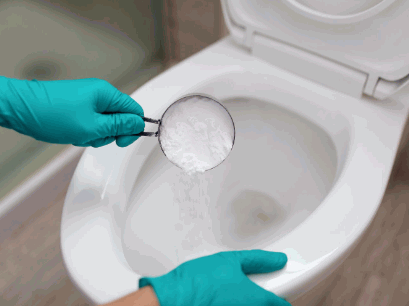
Using drain cleaner on a toilet carries certain risks, including potential damage to toilet pipes, exposure to harmful chemicals, and the risk of accidental injury during the application or handling of the cleaner.
When drain cleaner is poured into a toilet, it can lead to corrosion and deterioration of the pipes over time, which may result in costly repairs or replacements. The harsh chemicals in drain cleaners can pose serious health risks if inhaled or come into contact with skin or eyes. These chemicals are not only harmful to humans but can also cause environmental damage if not handled properly. The risk of accidental injury remains high, especially if the cleaner splashes or spills during use.
Seeking safer alternatives is crucial. One effective method is to use natural homemade cleaners like bicarbonate of soda and vinegar, which are less abrasive and toxic. Regular maintenance and preventive measures such as using drain guards can also help prevent blockages without the need for harsh chemicals.
The use of certain drain cleaners in toilets can lead to damage to the toilet pipes, especially in cases of prolonged exposure or incorrect application. Harsh chemicals may corrode or weaken the pipes, exacerbating the existing blockage issues.
Identifying signs of pipe damage caused by these cleaners includes unusual noises during flushing, slow drainage, or water leakage around the toilet base. In severe cases, visible cracks, bulges, or discoloration on the pipes can indicate significant harm. To prevent such damage, opt for non-corrosive, enzyme-based cleaners or natural solutions like baking soda and vinegar. Regular maintenance, such as scheduled inspections by a plumber and periodically flushing the pipes with hot water, helps maintain the plumbing system's integrity and longevity.
Many drain cleaners contain harsh chemicals that can pose health risks when used in toilets, especially in enclosed spaces. These chemicals may emit fumes or residues that can damage the porcelain surfaces of the toilet and cause environmental contamination.
The chemical components in these cleaners can also have harmful effects on indoor air quality, leading to respiratory issues or aggravating existing conditions. It's crucial to be aware of the potential dangers associated with these products to ensure the safety of your home environment.
To mitigate these risks, consider opting for safer alternatives such as eco-friendly or biodegradable drain cleaners that are less harsh on materials and the environment. Always follow manufacturer instructions carefully, use protective gear when handling chemical cleaners, and properly dispose of any leftover products according to local regulations.
61a, Walton St, Walton On The Hill, Tadworth,
Surrey, KT20 7RZ
info@amorybrown.co.uk